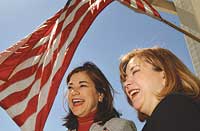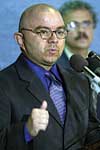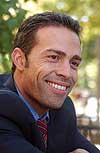|
 |
|
Esta página no está disponible en español. HISPANIC MAGAZINE.COMPolitical PuzzleBy Ana Radelat
May, 2002
An activist since she was in high school, the 33-year-old Democratic firebrand never thought she’d follow her older–and more conservative–sister Loretta Sánchez into political office. But that changed when the California legislature created a new Latino majority district in her Los Angeles neighborhood this year. "These kinds of opportunities don’t come every day," Linda Sánchez says. For most Latinos who hope to run for Congress, those kinds of opportunities appear only once every 10 years, when states redraw their political maps to reflect changes in population determined by the U.S. Census Bureau. When the nation was forced to redraw its political lines after the 1990 census to give Latinos greater representation in Congress, the Congressional Hispanic Caucus grew from 11 members to 17. Hispanics who hoped for a similar increase this year are bitterly disappointed. While the latest census figures show that the Latino population rose by nearly 58 percent between 1990 and 2000, Sánchez may be one of only a handful of Hispanics elected to the House in November. While redistricting isn’t finished in some states yet, it appears that only two new congressional districts will have Hispanic majorities besides the one Sánchez hopes to represent–one in Arizona and another in Florida. "This round of redistricting was about the politics of incumbent protection,’’ says Larry González, a lobbyist for the National Association of Latino Elected and Appointed Officials (NALEO). While the Hispanic community is slowly maturing politically, it is still very difficult for a Latino to win in areas that lack large numbers of Latino voters. In the 10 years after the 1990 redistricting, only one new member joined the Congressional Hispanic Caucus–Loretta Sánchez. And the Latina’s victory was attributed largely to the fact that there had been a sharp increase in the minority population of the Orange County district in which she ran. Besides limited "crossover" appeal, Hispanic candidates face other obstacles. Among them is that the Hispanic community is a young one; almost 40 percent of the nation’s Latinos are not yet voting age. Other Latinos can’t vote because they’re not citizens, and yet others are apathetic. In deciding against creating more congressional districts for Hispanic candidates, state legislatures were under a number of influences. In many states, the Democratic Party fought against the creation of a new Hispanic majority district because it would "bleach out" Latinos–who tend to favor Democratic candidates– from other districts and imperil Democratic incumbents. In fewer instances, the Republican Party determined it would be hurt by the creation of a new majority-minority district. Sometimes, it was Latino leaders themselves who quashed the creation of a new Hispanic majority district. That seemed to be the case in south Texas, where the Mexican American Legal Defense and Education Fund was pushing to create a new Latino district.
Rep. Charles González, D-Texas, worried that his San Antonio-based district would drop from 60 percent Hispanic population to 51 percent and threaten his re-election. He argued he needed a substantial Latino majority in his district to be able to win because of the low voter registration numbers in the Latino communities. Even though González fought to keep a substantial Hispanic majority in his district, he argues there are plenty of opportunities for Latino candidates–even in areas where there are few Hispanic voters. "If you look at the raw numbers [of new Hispanic districts] you can say we’ve been shortchanged," González said. "But that’s not the real world." NALEO’S Larry González (no relation) also said the political climate for Latinos could be a lot worse. "Is the cup half-empty or is it half-full?’’ he asks. "Even in spite of this round of redistricting, it would be half full.’’ Like Charles González, Larry González has hopes for several Hispanics who are running for Congress in areas that are not heavily Hispanic. If they win, they would be the first to be elected to the House from a district that isn’t at least 40 percent Latino. Darío Herrera, a 28-year-old Cuban American, is running as a Democrat for a newly created seat in southern Nevada that is only 15 percent Hispanic. Several Mexican American candidates also are running in two new districts in New Mexico where Hispanics are a minority. In addition, former policeman Eddie Díaz, a Puerto Rican Democrat, is considering a run against an incumbent in an area in central Florida where Hispanics are only about 10 percent of the population. Latino advocates are also encouraged that high-profile Latinos are running for several statewide seats this year–for governor and the U.S. Senate in Texas and for governor in New Mexico. A Latino hasn’t been elected to the U.S. Senate since 1976, there are few Hispanics holding statewide office and none in any governor’s mansion. But Larry González believes the number of qualified Hispanic candidates for federal office is likely to grow in the next 10 years. Few Latinos serve in state legislatures, the best breeding ground for congressional candidates. Only about 200 of the nation’s 7,400 state lawmakers are Latino. But according to the Latino officials association, the numbers of Hispanics in lower offices on school boards and in city halls is growing. Larry González says the 5,200 Hispanics in these offices are creating a political structure that will result in a future explosion of Hispanic political power that may be felt after the nation undergoes another redistricting in 10 years. "Do we need more people? Absolutely,’’ Larry González says. "But the fact is we have to maximize the opportunities we have and continue to build.’’ Linda Sánchez says the idea of running for Congress in a district that’s home to many low-income Hispanics was a "natural progression," the logical next step in a career that included work as a civil rights attorney and labor leader. But, like Larry González, Linda Sánchez hopes Hispanic politicians can someday win in areas that have lots of rich, white people. "Latino clout and Latino political maturity will happen when we can run and win in non-minority districts,’’ she says. While the makeup of California’s new district gives Linda Sánchez’s Republican opponent very little chance to win and almost guarantees her a seat in Congress, she’s suffered a backlash from some non-Latino voters in the newly configured district. "Some people took issue the seat was a ‘Latino seat,’ " Sánchez says. Raúl Grijalva, 52, has a good chance of joining Linda Sánchez in the freshman class of House members next year. He’s considered front-runner in a pack of eight Democrats and an independent running for a Hispanic majority district created this year in Arizona. The former head of the Pima County Board of Supervisors, Grijalva has held elective office for 25 years and is no novice to politics. He said he probably would run for Congress this year even if the new southern Arizona district lacked a Hispanic majority. Running in a district with no incumbents and a majority of Democratic voters was enticing enough. But the fact that the new district that stretches along the Mexican border was home to many Latinos "created more of an excitement and an urgency for the seat.’’ The son of a former bracero, the name given to Mexican immigrants who first came to work in American farms and ranches during World War II, Grijalva hopes Latinos have a greater voice in politics. But he’s also a realist. "Acknowledgement of Latinos in this country has been a slow process, and it’s been painfully slow in politics,’’ he says.
|

 November elections are still months away, but it’s almost a sure thing that Linda Sánchez will be a new face in the House of Representatives next year.
November elections are still months away, but it’s almost a sure thing that Linda Sánchez will be a new face in the House of Representatives next year.
 But Mexican American lawmakers who represented districts in the border area fought against the idea because it would mean they would lose some of their Hispanic constituents.
But Mexican American lawmakers who represented districts in the border area fought against the idea because it would mean they would lose some of their Hispanic constituents.